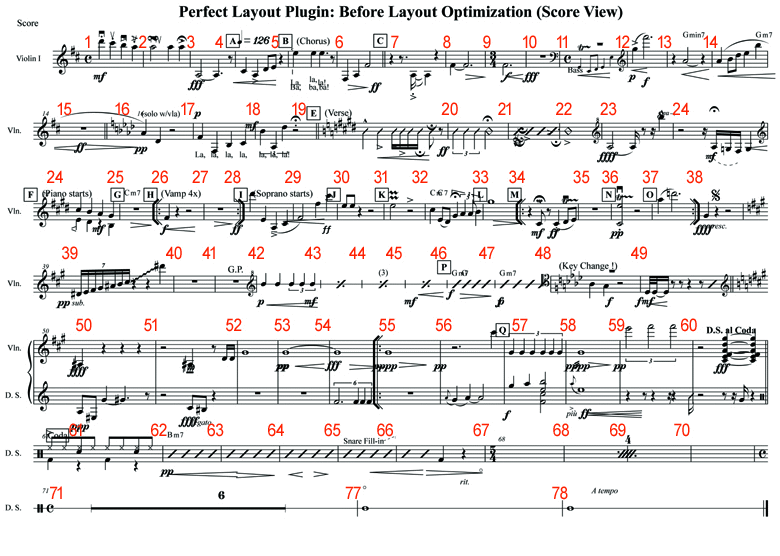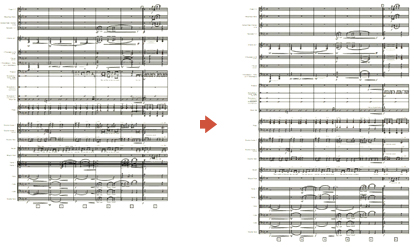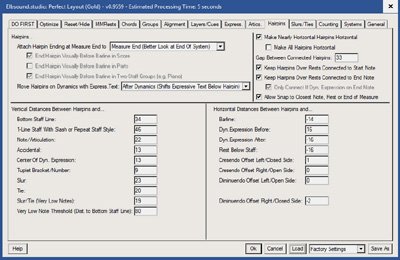These issues can't be fixed because of limitations in JW Lua or Finale, or they will be fixed in a future update.
- The installer currently doesn't support Windows user folders with unicode characters (i.e. the folder c:\users\.....\). At the moment only symbols from Windows-1252 encoding are supported (i.e. allowed are Western European symbols like äôáèüß, but not letters like ǧȒʥԖש).
- No support for scores with staff dependent time signatures.
- GPOS tables in OpenType fonts are currently not supported by our font engine (e.g. vertical glyph placement as in the Figurato font currently leads to wrong metrics in the plug-in)
- Finale 27: SMuFl .json files are not taken into account for the symbol metrics. Perfect Layout uses the actual symbol metrics from the font file.
- Diagonal hairpins are only partially supported.
- Non left-aligned chords are only partially supported in collision detection.
- The chord styles Solfeggio, Nashville and Roman are not yet supported in collision detection (the plugin always assumes one of the CDEFGA(BH)-standards).
- Cross-staff smartshapes are not supported for collision detection.
- The activated option "Allow Horizontal Split" in the measure dialog is only partially supported. It's not very recommended to use this feature anyway, because not even Finale supports it fully. It's recommended to fake a measure split with two measures, fake time signature settings and a hidden right barline.
- Dynamics on cross-staff notes in two-staff groups (e.g. piano) are only partially corrected in placement.
- Not all cross-staff scenarios are yet supported for optimal staff/system balancing. Should you notice any problems, please let us know, so that we can support them.
- Staves or staff styles with line spacing other than the default 24 EVPU are not fully supported yet which may lead to collisions or unoptimized spacing.
- No support for non-smart (=old-style) word extensions. These can not be detected correctly in JW Lua. Please activate "Use Smart Word Extensions" in the Lyrics->Word Extension dialog.
- Some fonts will work better on Windows/macOS if they are/are not added to MacSymbolFonts.txt. The plug-in font database currently only supports the state that works better on Windows. As a result the plug-in might require to update the MacSymbolFonts.txt file, if it doesn't find the correct fonts listed.
- Multi-measure rests are automatically created/validated. But as this may affect the system layout, it's possible that systems end up on different pages than before or that extra pages are added somewhere in between. Automatic multi-measure rest creation should be avoided if the part has systems with different number of staves (e.g. hidden staves) and many empty measures that would be consolidated to a multi-measure rest. This would massively influence the part layout. In this case create the multi-measure rests manually before calling the plugin and adjust the measure layout to your needs.
- The left/right metrics of consolidated rests are not always calculated correctly (JW Lua or Finale plugin SDK bug). The best result appears when the active layer in Finale is layer 1.
- In custom line definitions the values in the "Line Adjustments" group (Start H, Continue H, End H, V) cannot be read by JW Lua. If possible, set them to 0, otherwise the lines may align wrong.
- Rests in very ambiguous time signatures are not corrected (e.g. 11/4).
- The very old Finale "
Special Parts Extration" feature from the 90s is only partially supported and tested as it's usually not used nowawadays anymore.
It's recommended to use Finale's linked parts or extracted parts instead.
- Chord spacing is not fully correct in measures that have all of the following properties: slash/repeat style, overlapping chords, more notes than chord positions and not notes on all chord positions.
- Tracking (of text elements) is not calculated 100% correctly.
- Diagonal hairpins that cross staff lines are made horizontal.
- Finale's tool palettes are sometimes resorted by the minimization and maximization of the Finale Windows. We are still looking for a solution to this phenomenon.
- System/staff balancing may not work optimally if the pages have different scaling percentages.
- Automatic staff system balancing works best when all pages have the same page scaling, system scaling and staff scaling. Should they not match, it is not guaranteed that the result over all pages is fully convincing.
- When clicking on "Undo" and then on "Redo" after having run the plug-in, JW Lua or the Finale PDK has a bug that may lead to a different page layout/measure spacing or even systems vanishing in the score. It's possible to use undo/redo, but use it with care - i.e. check the page layout is still ok.
- The staff stem setting "Always Up" and "Always Down" cannot be detected (JW Lua bug). This can lead to stems being falsely flipped.
- Fingering articulations are only supported in articulation stacking if they have a horizontal offset of 0.
- Stacked hairpins (one above the other) are currently not handled correctly and might be placed on top of each other.
- Hairpins are vertically aligned to dynamics, expressive text, articulations, slurs, ties, notes and the staff line. Other symbols (e.g. custom lines) between hairpin and the staff line are currently not taken into account.
- Graphics attached to measures are currently not supported by JW Lua. So they are not taken into account for collision detection (Page graphics aren't taken into account either, as page elements aren't taken into account in general).
- Expressive text as custom smart lines (e.g. cresc. - - - -) is currently not automatically aligned with dynamics.
- Accidentals as expressions are not taken into account for collisions.
- Glissando smartshapes are not connected correctly to the notes, if their custom smart lines use an offset ("Start H" and "End H" values). JW Lua doesn't support reading this offset.
- Collision detection of rehearsal marks, tempo marks and tempo alterations only works good if there are at maximum two expressions per measure at the same measure position from two different expression categories.
- The clef slots are assumed to be used as in the Finale default document (i.e. slot 1=violin clef, slot 4=bass clef, etc.).
- JW Lua doesn't allow the detection of full or short barline in 1-line staves, so they are both aligned identically.
- Three stacked articulations (e.g. downbow, fermata and accent) are not included in collision removal.
- Lyrics baseline optimization currently only works for lyrics below the staff.
- All staff systems on a page should have the same Staff Height value.
- Document options for tie placement currently can't be read through the plugin interface, so the plugin always assumes Finale's standard values for tie positionings.
- Tie alterations that affect the tie metrics are currently not supported, i.e. collisions might occur. The functionality is supported by the Finale PDK, but currently not implemented yet in JW Lua.
- Collision of articulations with ties on top of the staffline is currently not supported yet, but also occurs rather seldom.
- Pickup duration detection is unstable: if a pickup measure is created with the "Use a different time signature for display" method and the second measure has a completely different time signature, the pickup is only detected if one of the first measures has at least one rest. (JW Lua bug: it has limited support for "Use a different time signature".)
- Automatic shape detection is currently switched off in Finale 2014 as JW Lua currently crashes Finale when examining shape instructions (i.e. down/up bow shapes are not detected as valid articulations for collision detection).
- Automatic detection of shape articulations is only supported in Finale 2014.5, 25, 26 and above.
- The few supported shape articulations (like "Up+Down Bow") must be designed "on baseline" (they must not cross below the baseline). Otherwise the stacked articulation collision doesn't work.
- As shape expressions are hardly supported, molto crescendo "end of hairpin" expressions are only detected if they are text expressions, not shape expressions.
- Shape articulations and expressions are currently not supported for collision detection.
- The articulation "inside slur" capability of Finale 26 is currently not supported by JW Lua. The plug-in automatic inside/outside slur feature only works up to Finale 25.
- Time signatures with decimals are currently not supported by JW Lua (e.g. .625/2 for a 5/16 time signature with one beaming group).
- JW Lua currently doesn't support updates of the Vertical Baseline Offset on shape expressions. This may lead to displaced expressions when they are baseline dependent and the baseline offset has changed.
- For all features to work with cross-staff notes, make sure to have the staves grouped. Cross-staff notes in non-grouped staves are not always detected correctly.
- Because of a Finale bug with the "Slur Tips Avoid Staff Lines" option, there may be collisions with slurs in rare cases that appear on the screen only. But: when printing the document to a printer or to PDF, the collisions are not visible.
- Hairpins that appear on three staff systems in a row are only checked for collision on the first and last system.
- Slur collisions are only detected correctly for slurs without line break or for the first system of slurs with a linebreak (i.e. slur collisions after the linebreak are only estimated very roughly or not taken into account at all, because of a JW Lua or Finale PDK bug).
- When an alert message dialog is clicked, Finale may lose the window focus (This is a known JW Lua bug). Simply click on the Finale window to get the focus back.
- Dynamic expressions might get close to steep beams. Those beams are currently not included in collision detection.
- You must not specify a different configuration folder name and directory other than Finale's default ("Configuration Folder" or "Konfigurationsdateien"). Otherwise the directory will not be detected and the plug-in doesn't work.
- The superscript command is not yet supported in collision detection and niente alignment.
- Rest optimization is currently not activated on slash and repeat style measures with multiple layers.
- Document default fonts (from the Document Options->Fonts menu) are only partially supported if they are set to "Fixed" size (which they usually aren't).
- Resized staff systems have not been fully tested yet (-> planned for future update). If possible, use other scaling options like staff height or page percentage and/or make sure all staff systems have the same scaling.
- Only partial support yet for individually resized staves.
- The plug-in has many optimizations for two-staff groups, like piano notation. These do not always work on three staff groups (e.g. a piano in contemporary three staff notation).
- User-defined font annotation files are currently not supported. Only the original font metrics are used. This can lead to incorrect metrics and thus collisions or too big distances if the Finale document loads user-defined FAN files.
- Staves that don't have 1- or 5 staff lines are only partially supported in spacing/collision optimizations.
- The values from the Smart Shape Placement menu are currently not accessible from JW Lua. So the plugin assumes the default values.
- A ttf, ttc, otf, dfont or suit font file must be available on the hard disk for font metrics analyzation in OS registered font directory, otherwise the metrics are not available.
- Priorization: manually adjusted tremolo articulations may be messed up when the connected note entry has illegal flags (like Special or Voice2Launch). So note entry flag correction has a higher priority than tremolo articulation placement. So it's recommended to run for example the
JW Yada Yada plugin after having run the Perfect Layout plugin.
- The plugin has not been tested with all international versions of Finale and might not fully work in these because of different keywords. If you notice a difference, please contact us.


